Related Research Articles

A suspension bridge is a type of bridge in which the deck is hung below suspension cables on vertical suspenders. The first modern examples of this type of bridge were built in the early 1800s. Simple suspension bridges, which lack vertical suspenders, have a long history in many mountainous parts of the world.

Forensic engineering has been defined as "the investigation of failures—ranging from serviceability to catastrophic—which may lead to legal activity, including both civil and criminal". The forensic engineering field is very broad in terms of the many disciplines that it covers, investigations that use forensic engineering are case of environmental damages to structures, system failures of machines, explosions, electrical, fire point of origin, vehicle failures and many more.

A truss is an assembly of members such as beams, connected by nodes, that creates a rigid structure.
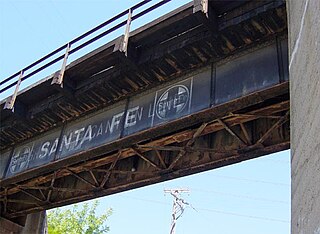
A plate girder bridge is a bridge supported by two or more plate girders.
The National Bridge Inventory (NBI) is a database, compiled by the Federal Highway Administration, with information on all bridges and tunnels in the United States that have roads passing above or below them. That is similar to the grade-crossing identifier number database, compiled by the Federal Railroad Administration, which identifies all railroad crossings. The bridge information includes the design of the bridge and the dimensions of the usable portion. The data is often used to analyze bridges and to judge their condition. The inventory is developed for the purpose of having a unified database for bridges to ensure the safety of the traveling public, as required by the Federal Aid Highway Act of 1968. It includes identification information, bridge types and specifications, operational conditions, bridge data including geometric data and functional description, and inspection data. Any bridge more than 20 ft long used for vehicular traffic is included.
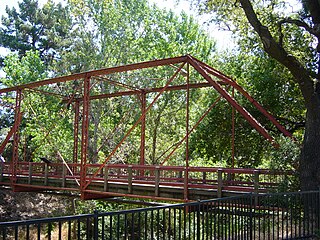
In structural engineering and construction, an eyebar is a straight bar, usually of metal, with a hole ("eye") at each end for fixing to other components. Eyebars are used in structures such as bridges, in settings in which only tension, and never compression, is applied. Also referred to as "pin- and eyebar construction" in instances where pins are being used.
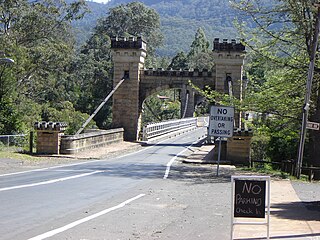
Hampden Bridge is a heritage-listed single-span suspension bridge that carries Moss Vale Road (B73) across the Kangaroo River, in Kangaroo Valley, in the City of Shoalhaven local government area of New South Wales, Australia. The bridge was designed by Ernest de Burgh and built by Loveridge and Hudson. The property is owned by Transport for NSW. It was added to the New South Wales State Heritage Register on 2 August 2019.
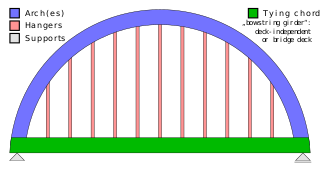
A tied-arch bridge is an arch bridge in which the outward-directed horizontal forces of the arch(es) are borne as tension by a chord tying the arch ends rather than by the ground or the bridge foundations. This strengthened chord may be the deck structure itself or consist of separate, independent tie-rods.
This is an alphabetical list of articles pertaining specifically to structural engineering. For a broad overview of engineering, please see List of engineering topics. For biographies please see List of engineers.

A Howe truss is a truss bridge consisting of chords, verticals, and diagonals whose vertical members are in tension and whose diagonal members are in compression. The Howe truss was invented by William Howe in 1840, and was widely used as a bridge in the mid to late 1800s.

Gusset plate is a plate for connecting beams and girders to columns. A gusset plate can be fastened to a permanent member either by bolts, rivets or welding or a combination of the three. They are used in bridges and buildings, as well as other structures.
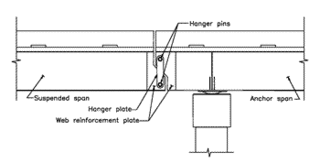
A pin and hanger assembly is used to connect two plate girders of a bridge. These assemblies are used to provide an expansion joint in the bridge. One beam is set on a pier with a short section cantilevered out toward the next pier. The other begins underneath the anchor span, and has its far end resting on the next pier. The beams have holes directly above each other. The two holes are connected using hangers, a pair of connecting plates sandwiching the bridge girders. A pair of large steel pins through the plates and girder webbing provide the hinges, holding up the suspended span while allowing it to move longitudinally. Large washers are bolted to each end of the pin to retain the hangers. Exceptionally long spans may have two sets of girders cantilevered from opposite bridge piers with a third set of girders suspended by pin and hanger assemblies from both cantilevers.
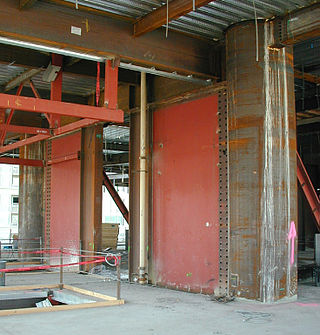
A steel plate shear wall (SPSW) consists of steel infill plates bounded by boundary elements.

Progressive collapse is the process where a primary structural element fails, resulting in the failure of adjoining structural elements, which in turn causes further structural failure.

The Silver Bridge was an eyebar-chain suspension bridge built in 1928 which carried U.S. Route 35 over the Ohio River, connecting Point Pleasant, West Virginia, and Gallipolis, Ohio. Officially named the Point Pleasant Bridge, it was popularly known as the Silver Bridge for the color of its aluminum paint.

The Godavari Arch Bridge is a bowstring-girder bridge that spans the Godavari River in Rajahmundry, India. It is the latest of the three bridges that span the Godavari river at Rajahmundry. The Havelock Bridge being the earliest, was built in 1897, and having served its full utility, was decommissioned in 1997. The second bridge known as the Godavari Bridge is a truss bridge and is India's third longest road-cum-rail bridge crossing a water body.
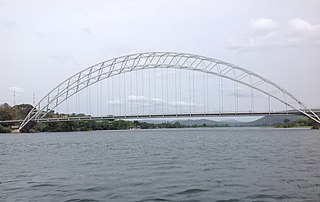
The Adomi Bridge is a latticed steel arch suspension bridge crossing the Volta River at Atimpoku in Ghana in West Africa. It is the first permanent bridge to span the Volta River, which drains south into the Gulf of Guinea, and is Ghana's longest suspension bridge. It provides the main road passage, just south of the Akosombo Dam, between the Eastern Region and the Volta Region of Ghana. It was opened in 1957 by Kwame Nkrumah, Ghana's first president. The iconic crescent-shaped arch bridge is featured in Ghanaian stamps and currency.

Structural integrity and failure is an aspect of engineering that deals with the ability of a structure to support a designed structural load without breaking and includes the study of past structural failures in order to prevent failures in future designs.

On May 23, 2013, at approximately 7:00 pm PDT, a span of the bridge carrying Interstate 5 over the Skagit River in the U.S. state of Washington collapsed. Three people in two different vehicles fell into the river below and were rescued by boat, escaping serious injury. The cause of the catastrophic failure was determined to be an oversize load striking several of the bridge's overhead support beams, leading to an immediate collapse of the northernmost span.
This glossary of structural engineering terms pertains specifically to structural engineering and its sub-disciplines. Please see glossary of engineering for a broad overview of the major concepts of engineering.
References
- ↑ McGinty, Jo Craven; Overberg, Paul (March 29, 2024). "These Eight U.S. Bridges Are Vulnerable to a Repeat of the Baltimore Crash". The Wall Street Journal. News Corp. Archived from the original on April 1, 2024. Retrieved May 10, 2024.
- ↑ Connor, Robert H.; Frank, Karl; McEleney, Bill; Yadlosky, John (January 2015). "Bridge Crossings: Are You Sure That's Fractuire Critical?" (PDF). Modern Steel Construction. American Institute for Steel Construction. Retrieved 29 March 2024.
- 1 2 Kaviani, Peyman; Villalobos, Carlos (October 2016). "Fracture Critical Bridge Inspection". Structure. National Council of Structural Engineers. Retrieved 29 March 2024.
- ↑ Connor, Robert; Gilmer, Heather; LLoyd, Jason; Medlock, Ronnie; Wasserman, Ed. "Implementation of Redundancy Terms under 2022 NBIS" (PDF). Ameican Institute of Steel Construction. Retrieved 1 April 2024.
